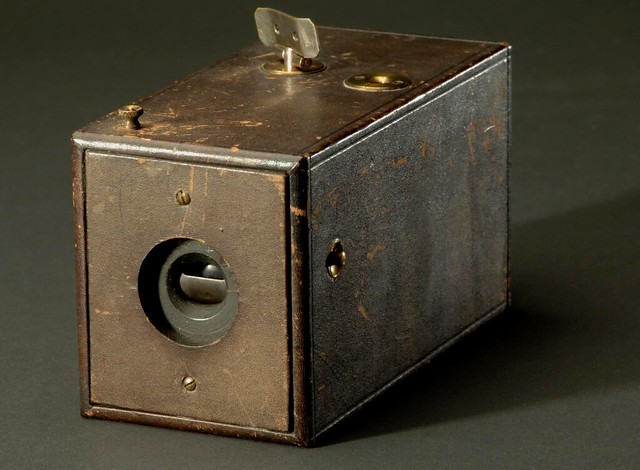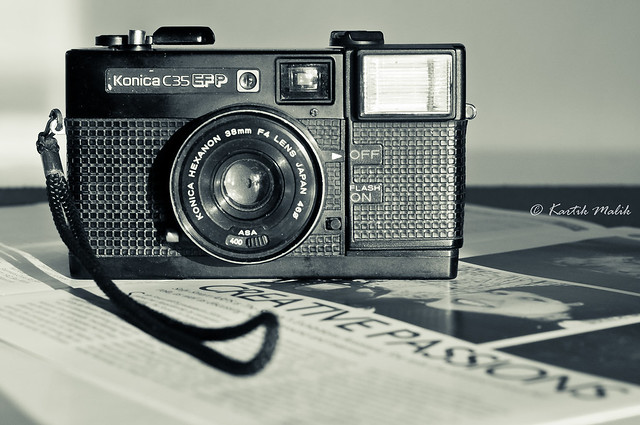My recent fling with The Konica C35 AF got me thinking about what true point and shoots (P&S) there out there. By that I mean a P&S where all the user does is hit the shutter button and possibly wind on – there is no need or ability to set any other controls once the camera was loaded.

Here is my thought on 10 examples.
By point and shoot we are meaning a camera where you simply hit the shutter to take a shot. So focus either has to be fixed or auto focus. The exposure has to either be fully automatic or a fixed aperture and shutter in standard use. A camera can have more settings such as bulb mode or a manual mode but this can’t be the ordinary mode and the user needs to select those settings out with standard use. I’m sticking to cameras that are mass produced for consumers. Film type isn’t important and I’m only stick to analogue film cameras
1 In the beginning there was…
The Kodak – 1888

George Eastman opens the show the year after Queen Victoria’s Golden Jubilee. This incredibly simplistic box camera really was point and shoot with no viewfinder and a string tensioned shutter. Loaded with a 100 shot roll, you had to send the camera back to Kodak to get the film swapped out and the camera was a princely $25 in those days (probably the same a months salary for an upper working class ). But we have a fixed focus shooter with a fixed aperture and in normal use a single shutter speed (you could do timed if you really wanted). P&S had arrived your Majesty. Not that you’ll see one out with museums or collectors nor really could you use one.
2 Photography for the masses –
The Kodak Brownie – 1900

Queen Victoria was still on the go in 1900 when George Eastman’s company came up with this ultra simple box camera made of strengthened cardboard for the masses. Sold for just One US Dollar and with user reloadable cheap film Eastman hit a winning format which gave rise to the mass camera market. We have all we want here in a P&S with a simple fixed focus lens with a single aperture and shutter. Like it’s predecessor it was launched with no viewfinder (a later add-on). Rare to see now and not cheap, the camera also uses a long defunct film format so really one for the collectors. The Brownie No 2 is much more plentiful and take 120 film but technically doesn’t quality with 3 aperture setting.
Kodak’s Brownie series spanned the bulk of the 20th Century ending with the 110 model launched in the UK in 1980 and later as the Brownie II in Brazil. It was a true P&S with fixed shutter, aperture and focus abet in 110 form

3 I’ve got an (electric) eye on you…
Bell & Howell Electric Eye 127 – 1958

Although Kodak developed an auto exposure system with their 1938 Rangefinder the unsuccessful Kodak Super Six-20, autoexposure didn’t really take off until the 1950’s. This simple 127 film fixed focus box camera pips Kodak Brownie Starmatic to the post of the first automatic exposure P&S . Both cameras like many to follow used a selenium cell to detect the light and set the exposure (the so-called electric eye). In Bell & Howell’s camera this controlled the 2 aperture blades and the camera had a single shutter. A warning red arrow appears in low light. Although simple still a massive jump for the P&S.

In a short space of time smaller and more sophisticated systems developed and a good example is of the Half frame Olympus PEN EE camera first seen in 1961. These stylish fixed focus cameras have razor-sharp optics and by the time of the EE-2 a few years later a revised metering system was a direct copy of the classic full frame compact the Olympus Trip 35. The last model the PEN EF added built-in flash
4 Shape of all to come
Konica C35 AF – 1977

The Konica C35 AF is a true landmark camera both for photography in general and P&S. This is the world first commercially made AF camera. Building on the design, optic and exposure system of the legendary C35 series of 35mm compacts, what you have here is the first fully automated camera. You still need to turn the flash on (there is a helpful warning light) but that’s about it. The passive AF system is works like an automated rangefinder. It is clunky and would largely be replaced on compacts by active AF in a short space of time
5 Flash backwards ?
Konica C35EFP -1978

Another appearance for a C35 camera here but a much simpler affair than the C35 AF above although both share some common roots with arguably the first 35mm compact with built-in flash the zone focus C35 EF. That had full metering and influenced both the AF and EFP. But the EFP is a simpler affair. It has the same built-in flash as its siblings but it’s a fixed focus affair with effectively fixed exposure. Essentially when you set the film speed you adjust the aperture which is otherwise fixed- the CdS metering system just warns you of low light and to turn on the flash.
A slew of these fixed focus and exposure flash cameras were made alongside metered fixed focus P&S like the Canon snappy 20 or the evolving AF point and shots. Into the Eighties like many cameras they became more angular but still popular with cameras like the Olympus Supertrip. Automatic flash was added to some like the cult classic Halina Micro 35 (aka the Hong Kong Lomo) and motorwind.

6 A Zoom with a view
Pentax Espio/IQzoom series- 1986

In 1986 less than a decade after Konica’s milestone AF camera, Pentax launched one of the first compact AF zoom compacts with the IQzoom. This series would morph into the Espio in Europe (although still called IQZooms in the US).

I’m more familiar with the 1992 Espio AF zoom pictured above which whilst being much more refined, still shares many of the similar features to the original IQZoom. Both are DX coded motorwind beasts that mean the user really needs to do little more than drop in the film and have multi element zoom lens. The espio is much smaller than its big brother and has a LCD screen for setting although you can just turn on and point and shoot (for this purpose we’ll ignore the zoom). Unlike the C35 AF the flash now automatically triggered and you could lock focus and exposure. Eerily similar to any modern digital compact the only difference being using film and an optical viewfinder rather than sensor and LCD viewer.
7 Throwaway Fun
The Fuji Quicksnap & others 1986

Fuji gave us what we would understand as the arguably the first disposable camera in 1986 with their original Quicksnap. Three decades later disposables still make up a sizable chunk of the film market. Fujifilm, Kodak & Ilford’s offerings being worthy of note. You get a fixed focus lens with fixed shutter and aperture and usually a manually activated flash. Some are designed for use underwater. The P&S you can take anywhere and not worry and strangely reminiscent of the Kodak
8 A Bridge too far
Yashica Samurai x3 1987

Wikipedia defines a bridge camera as “cameras that fill the niche between the single-lens reflex cameras (SLRs) and the point-and-shoot camera” and these days usually refer to muscled big zoom digitals that look like a dSLR but lack the optical viewfinder and lens interchangeability. But the term predates these cameras and arguably originates with the Yashica samurai series. These were non interchangeable zoom lens SLR with minimal user options. Yashica’s models were first to market narrowly beating the Ricoh Mirai & Chinon Genesis both of which whilst weirdly sci-fi looking bear more resemblance to modern bridge cameras. The Yashica was styled like a video camcorder that were all the rage at the time and also was half frame and came with mutimodes, timer, databack and a built-in flash
9 Irony snapped
Nikon F-401/ N4004 1987

Uh… That’s an SLR
Well it is but it can also be considered as a point and shoot. Not Nikon’s nor by any stretch the world’s first AF SLR the F-401 was launched as Nikon’s entry level AF SLR. Sure you can shoot manually or in Aperture priority or shutter priority modes and focus the lens if you want but equally you can load a film (easy load with DX coding) and leave the thinking to the camera.
I’ve picked this over the first AF SLR the rare Nikon F3AF & other early Nikon AF SLRs as it is more practical, intended for the man on the street and has the first built-in TTL flash SLR in the world (granted you need to manually switch on) and was one of the first cameras with pronounced side grip. But that is a moot point and you might argue not just for an earlier Nikon like F-501 but for the likes of the Minolta 9000
10 Back to basics
Vivitar Ultra Wide and Slim-
Date of Origin Unknown still in production

This 21st century tiny plastic 35mm marvel takes us right back to the beginning with the Original Kodak & Brownie and is pretty typical of many Lo-fi cameras out there. Like the original brownie it has a simple fixed focus lens, one aperture and one shutter speed and other than the shutter button a catch for film compartment that’s it. Still in production as the Superheadz wide and slim and a cult classic itself due to the incredible plastic lens.
So what do you think ? Have I missed anything. I did wonder about the Polaroid cameras like the 1000. If I was being a pedant I would have included the first digital P&S but this is a film blog…
Further Reading/References
camera-wiki.org – as ever an excellent guide to the cameras
Classic Cameras – The Auto-Exposure Class of 1959 – handy guide to early auto exposure cameras (the B&H was 1958 though..)
The Brownie camera page – excellent resource on Brownie cameras

I will second the Superheadz White Slim Angel(amongst other names), if you only have one all plastic camera – this should be it!